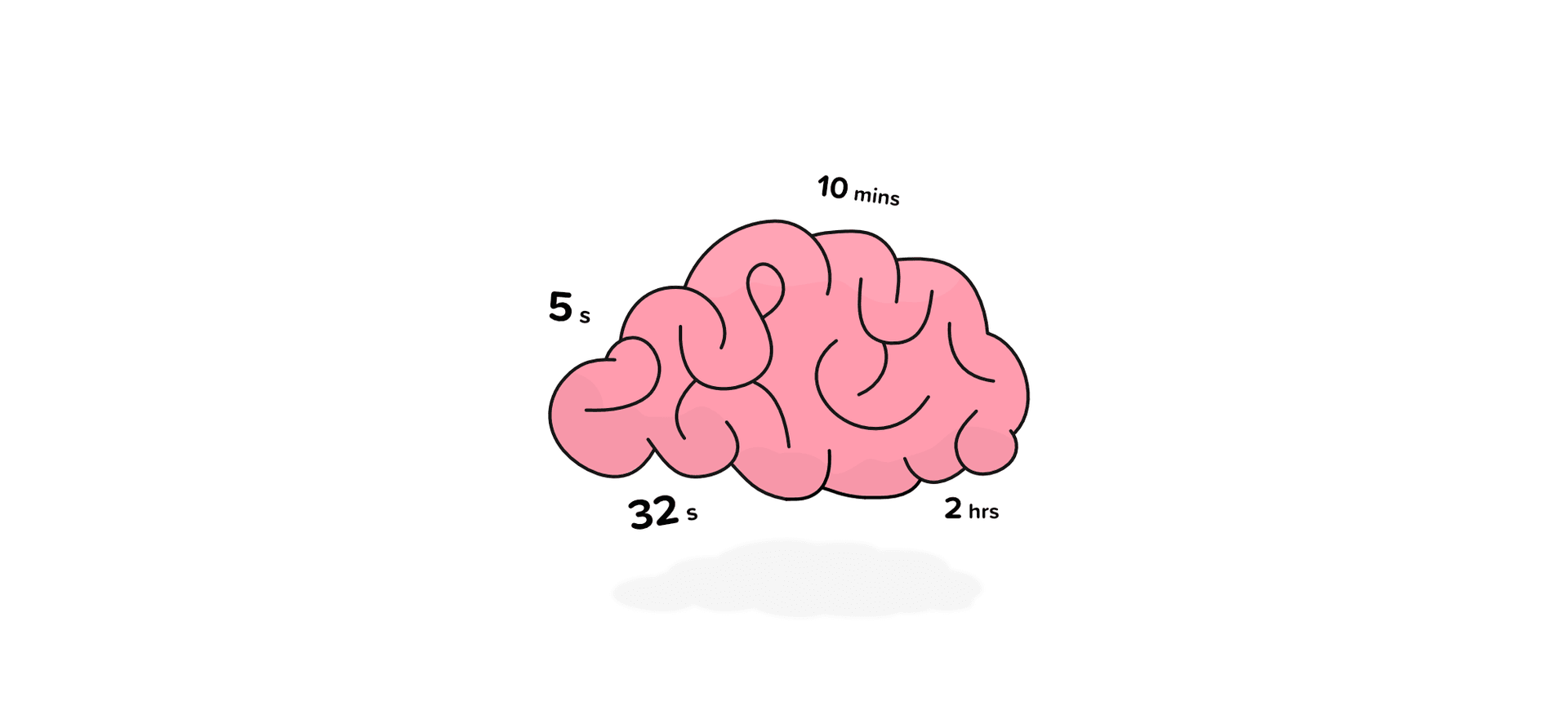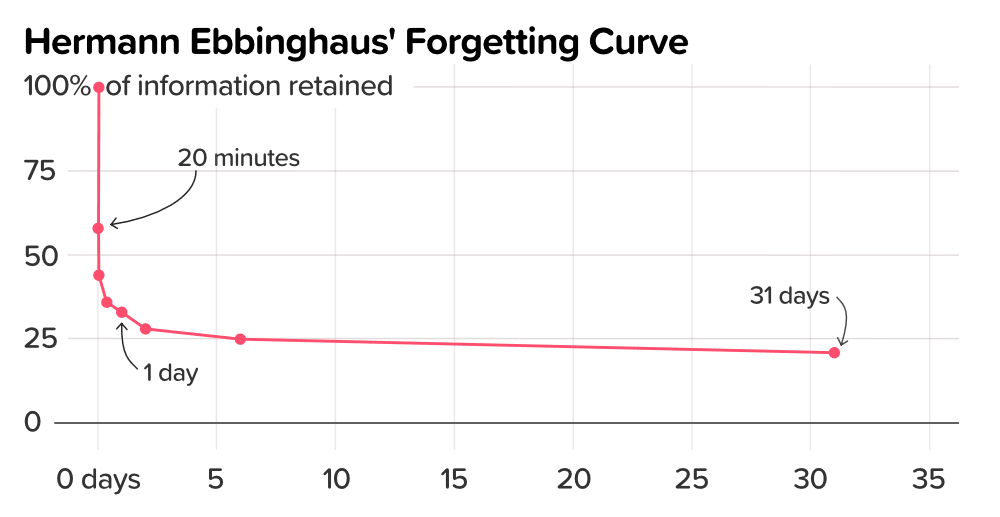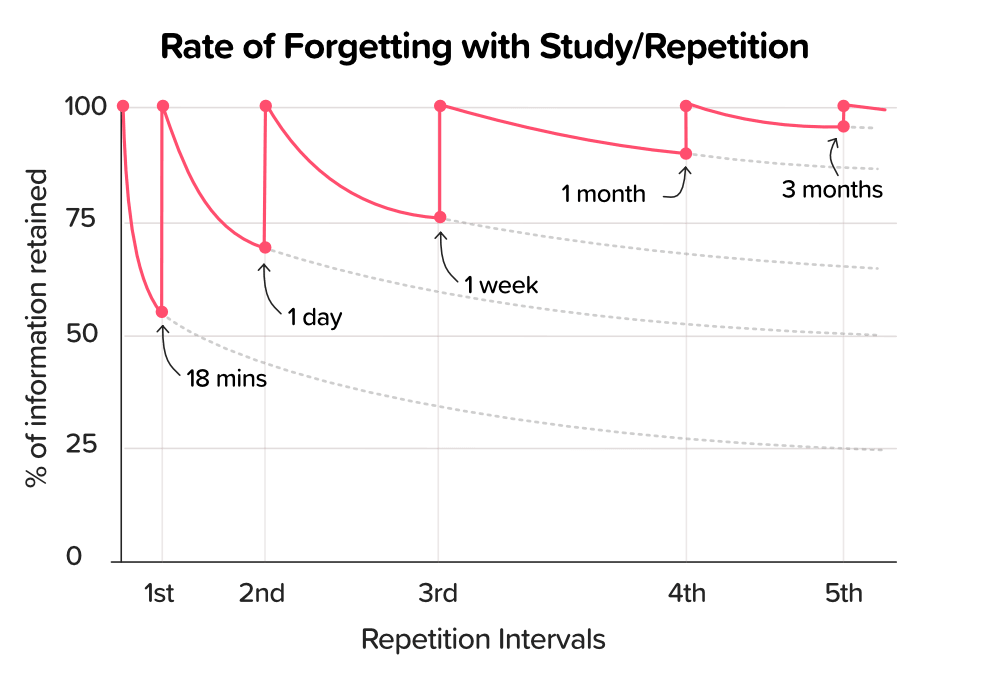
If you’re a student, you’ve probably trialled and tested various studying methods to figure out how you can study for the least amount of time whilst still getting good grades. It may seem unfair that whilst you slave away at your desk for hours, others ace the test with minimal amount of effort. You may pin this down to their intelligence or inherent abilities and accept they’re just smarter than the average person. But that’s where you’re wrong. Sometimes, the only difference between you and the class genius is the learning technique you’ve adopted.
Research shows that it is not only what you learn that matters but how you learn. We’ve done the research for you and will be sharing 3 scientifically proven methods that may be the missing piece you need to excel at university!

1. The Ebbinghaus Forgetting Curve
Ever studied hard the night before a big test only to completely blank on the big day? You’re not alone. A study on the human memory in the late 19th century by German psychologist, Hermann Ebbinghaus, shows that human beings forget at an exponential rate and this occurs most rapidly immediately after learning.1
Ebbinghaus conducted a series of experiments on himself to examine the rate at which memories are lost over time. He memorised a list of made-up syllables (e.g. DIF, LAJ, LEQ, WYC etc). and then periodically tested to see how many he could remember at different points in time. Much like any student who has crammed the night before, Ebbinghaus discovered that his rate of retention declined rapidly early on but eventually levelled off so that he could remember a few syllables for a long time afterwards.
This can be summarised in what is commonly known as ‘The Forgetting Curve’.

The graph shows that by the end of the 1st day, almost 75% of the information has been lost. Sound familiar? This implies that whilst cramming might help you scrape that pass on your test the following day, you are unlikely to remember anything come the time of the exam and it will be as if you are starting from scratch. In other words: cramming does not work.
So how do you overcome this? Ebbinghaus discovered that the steepness of the forgetting curve can be reduced by a learning technique known as the Spacing Effect. This involves reviewing the material over time, as opposed to squeezing it all into one session.
For this technique to work, reviewing should initially occur more frequently because the longer you wait between reviews, the more information you will have to relearn. As the rate of forgetting declines, the frequency can be reduced over time. The graph below shows that after periodic reviews, the curve significantly flattens.

What does that mean for you? If you review your notes once, you will remember roughly 50% after 20 minutes but if you go over them a second time that week (preferably the next day), you will retain 80% of the information till the end of the week. And if you go over it once more that week (maybe the morning of the test), you will retain 90% of the information for the rest of the month! Try this out the next time you study and notice a drastic improvement in your ability to recall information.

2. The Pomodoro Technique
The second learning technique is a time management tool that will help you power through tasks using short bursts of intense concentration. Developed in 1992 by Francesco Cirillo, it involves working for 25-minute intervals (called pomodoros) followed by a 5-minute break.2 The main idea is that by focusing for short periods of time and involving regular breaks, you are able to remain productive without burning out. Fun fact: the technique gained its name from the tomato-shaped timer used by Cirillo whilst studying (pomodoro is Italian for tomato).
The technique involves six steps in order to be used effectively:
- Plan out your day by writing down a list of tasks.
- Once you have a basic game plan set your timer and immerse yourself in a task for 25 minutes.
- Stop working when the timer rings and record one pomodoro.
- Take a 5-minute break to assimilate the information.
- Repeat 3 more times and then take a longer 20-minute break to clear your mind and refresh.
- Repeat.
Simple enough right?
Frequent use of this technique will build good habits by training your brain to ignore distractions and improve your attention span. In order to do this, you must commit to the task without any interruptions. Put your phone away and turn off notifications to completely zone in on the task. If you are distracted mid-way, it is advised to either stop there and restart the pomodoro from where you left of or, preferably, put off the distraction until 25 minutes are complete. If repeated enough times in a day, you will be amazed at how much you can get done.
Despite being a useful technique, this method might not work best for everyone. You may be someone who prefers to work for extended periods of time rather than in short intervals or you may struggle to get back in the zone after a break. If this is the case, customise the time to suit you. After all, the main idea is to motivate you to be more productive so you can get more out of your day.

3. Retrieval Practice
Retrieval practice is a learning method you have probably come across before and involves trying to recall information from memory without having the information in front of you. Whilst this method of self-testing is not ground-breaking by any means, research has found retrieval practice to be a superior study method compared to simply re-reading textbooks or notes.3
Studies that compare the effect of repeat studying and repeat testing on learning have shown that retrieval practice enhances retention of information in the long-term memory. In addition, the retrieval of information from memory facilitates recall of related information. This method of studying also makes revision sessions more productive since students gain more from studying after taking a test compared to if they had not been tested.
In an experiment conducted by Karpicke and Roediger III,4 four groups of college students were asked to learn 40 words in Swahili and English and were tested 1 week later. The results showed that for the two groups that used repeat testing, students recalled about 80% of the words compared to roughly 30% recalled by the group with no repeat testing. The authors conclude that whilst repeat studying produced no benefit, repeat testing improved long term retention by more than 150%.
In a similar study, McDermott et al. found that primary school students performed better in exams on topics that were quizzed compared to those that were not reporting a 16-21% increase in grades.5
Hopefully we have convinced you that despite being a more challenging learning technique, the results are well worth it. There are numerous ways in which you can practice this method including writing out flash cards, teaching a friend, drawing out a mind map or even speaking to yourself (we won’t judge). Once complete, check for accuracy or missing points by revisiting your notes. This process of feedback will help you assess how well you understand the topic and identify gaps in your knowledge.
4. Key Takeaways
Now it’s up to you to put this knowledge into practice. Using more efficient studying techniques will not only be beneficial when exam time rolls round but will also allow you to have a better work-life balance throughout the year.
- Review newly learned material as soon as possible – make notes within a week of the lecture
- Carry out frequent review sessions – higher frequency at first and lower frequency later on.
- Take regular breaks – to absorb the information and recharge
- Self-test – to store information in your long-term memory
As the saying goes: work smarter, not harder. Good luck!
- Ebbinghaus, H. (1885). Memory: A Contribution to Experimental Psychology. New York: Columbia University.↩
- Cirillo, F. (2013). The Pomodoro Technique. Berlin: FC Garage.↩
- Roediger III, H., Putnam, A. and Smith, M. (2011). Ten Benefits of Testing and Their Applications to Educational Practice. Psychology of Learning and Motivation, pp.1-36.↩
- Karpicke, J. and Roediger, H. (2008). The Critical Importance of Retrieval for Learning. Science, 319(5865), pp.966-968.↩
- McDermott, K., Agarwal, P., D’Antonio, L., Roediger, H. and McDaniel, M. (2014). Both multiple-choice and short-answer quizzes enhance later exam performance in middle and high school classes. Journal of Experimental Psychology: Applied, 20(1), pp.3-21.↩

Take notes effortlessly
Join thousands of happy notetakers!